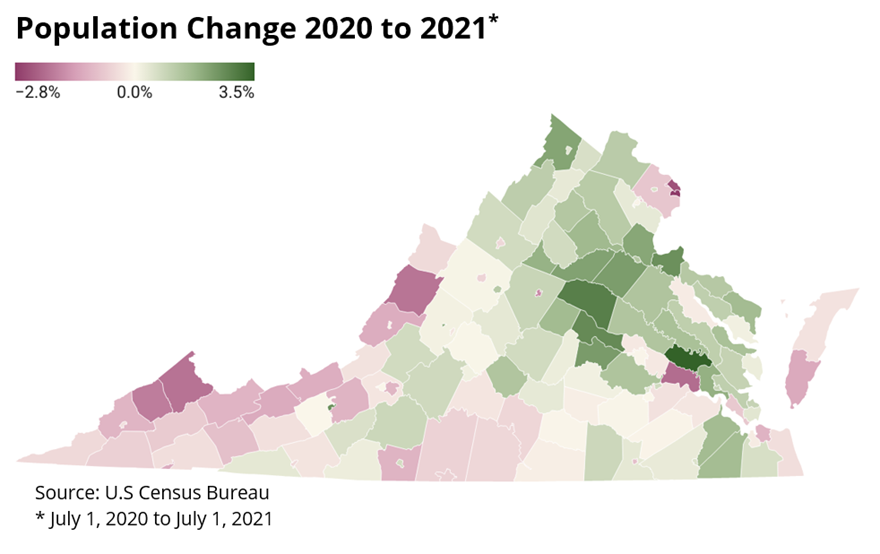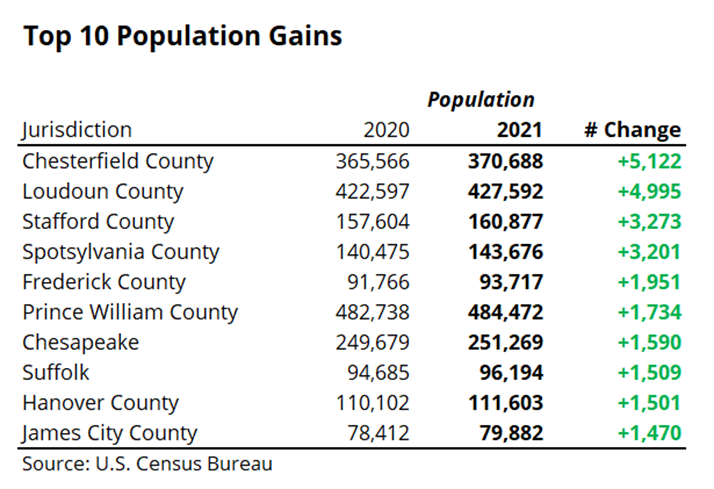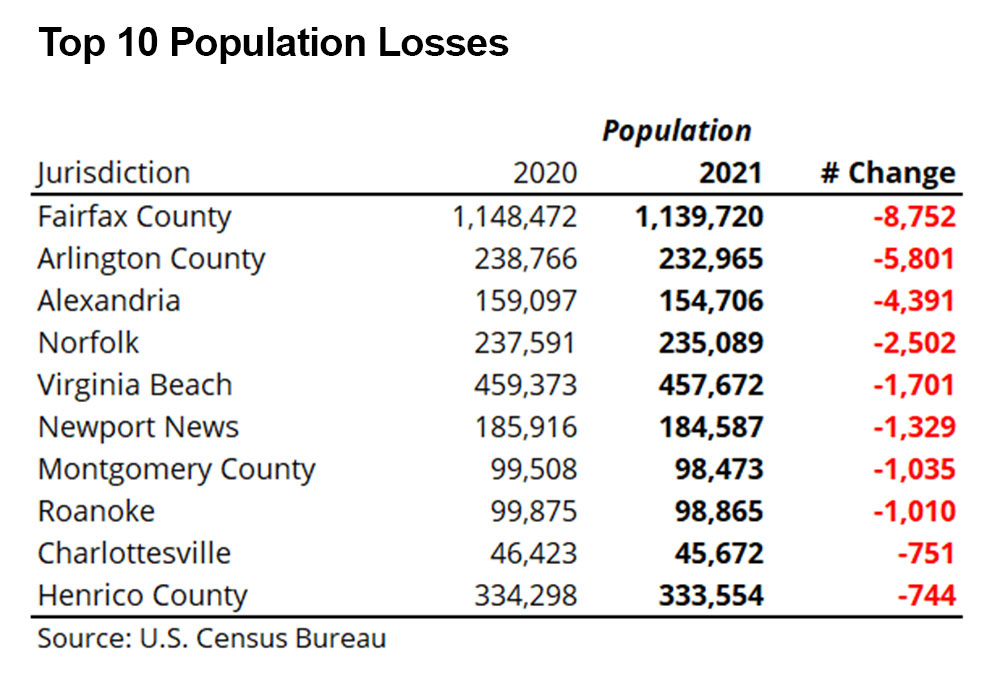Exodus from Cities Was Real Amid COVID
April 14, 2022
During the pandemic, we heard stories of people leaving cities for smaller communities, but we weren’t sure how widespread the trend was. Recently released Census data for Virginia provides evidence of the pandemic-induced flight from urban areas to suburban and exurban places. However, more recent home sales data suggests that as the COVID-19 pandemic has eased, people are returning to Virginia’s more urban markets.
In 2020, with the onset of the pandemic, we saw the rise of “zoom towns”, and second home markets were exploding. Fewer people wanted to live in condos and sought places with yards and more open space. Well, the latest population estimates just came in, and as we suspected from the housing market data, it appears it was mostly true.
Population boom in the suburbs, exurbs, and some rural areas.
According to the U.S. Census Bureau 2021 population estimates, Virginia’s suburban and exurban communities experienced the largest population growth between 2020 and 2021, while more urban areas saw their populations decline. In addition, many rural communities, particularly those near natural amenities in the mountains and in coastal areas had strong population growth during this same time period.

Nearly all the top ten jurisdictions with the largest population gains are located in the suburbs and exurbs of the DC/Northern Virginia region, the Richmond region, and Hampton Roads. The population growth in most of these suburban communities was driven by net positive domestic migration, which means more people moved in from other parts of Virginia and the country than moved out to those areas.
There are a couple interesting exceptions, however. Prince William County in Northern Virginia is in the top ten list for population growth between 2020 and 2021, but nearly all of this was driven by natural population growth (more births than deaths) and positive international migration. More than half of neighboring Loudoun County’s population gains were from natural change (more births than deaths), but unlike Prince William County, Loudoun County did have a net positive of people moving into the county from other places in Virginia and the country. Some rural areas such as New Kent County, Louisa County, and King George County among others also had relatively strong population growth during this time period, which was driven by net positive domestic migration.

People left urban communities, inner suburbs, and college towns.
The impacts of the pandemic on urban areas are clear in the population data. Domestic out-migration drove all of population losses in these areas, with more people moving out to other areas in Virginia and the rest of the country than moving in. However, between 2020 and 2021, all these communities had net positive international migration, that is, more people moving in from other countries than to other countries. Some of the most urban and dense communities in the state, such as Northern Virginia (Fairfax County, Arlington, Alexandria), and Hampton Roads (Norfolk, Virginia Beach, Newport News) lost thousands of residents between 2020 and 2021 from pandemic-era changes in living preferences.
Not surprisingly, the pandemic also impacted college towns, as more students were learning virtually from other locations, and many opted to pause their enrollment plans amid the uncertainty. Charlottesville, home to UVA, had about 750 fewer residents in 2021 compared to 2020 and Montgomery County (Blacksburg), home to Virginia Tech, had about 1,000 fewer residents during this same time period.

While the pandemic shifted where people want to live, it looks like that change was temporary, and urban and inner suburban areas have begun to draw new residents in as the pandemic eases. More recent housing market data suggests people are returning to cities, but we won’t know for sure until the official 2022 population estimates are released in 2023. We anticipate the growth in the urban markets will continue as more people return to offices, even if it is only a few days a week. Nevertheless, it is helpful to take a dive into the latest population data we have to uncover the key population trends that took place around the commonwealth in recent years.
For more information on demographic and economic trends in Virginia, be sure to check out Virginia REALTORS® other Economic Insights blogs and our Data Page.
You might also like…
Key Takeaways: October 2024 Virginia Home Sales Report
By Virginia REALTORS® - November 22, 2024
Key Takeaways There was a surge in closed sales activity in October in Virginia’s housing market. The influx of sales was driven by a jump in pending sales… Read More
A Profile of Renters in Virginia Over the Last Decade
By Dominique Fair - November 14, 2024
Renters have experienced a series of ups and downs in the rental market over the last 10 years. The U.S. Census Bureau has released their American Community Survey… Read More
More People Moved to Virginia Than Out of the State Last Year
By Sejal Naik - November 6, 2024
Each year since 2005, the U.S. Census Bureau determines whether respondents of its surveys lived in the same residence a year ago. If people have moved, then the… Read More